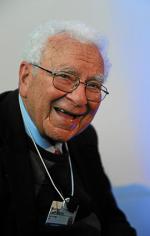Disable ads!
Murray Gell-Mann
Murray Gell-Mann (/ˈmʌri ˈɡɛl ˈmæn/; born September 15, 1929) is an American physicist who received the 1969 Nobel Prize in physics for his work on the theory of elementary particles. He is the Robert Andrews Millikan Professor of Theoretical Physics Emeritus at the California Institute of Technology, a Distinguished Fellow and co-founder of the Santa Fe Institute, Professor in the Physics and Astronomy Department of the University of New Mexico, and the Presidential Professor of Physics and Medicine at the University of Southern California. He introduced, independently of George Zweig, the quark—constituents of all hadrons—having first identified the SU(3) flavor symmetry of hadrons. This symmetry is now understood to underlie the light quarks, extending isospin to include strangeness, a quantum number which he also discovered. He developed the V−A theory of the weak interaction in collaboration with Richard Feynman. In the 1960s, he introduced current algebra as a method of systematically exploiting symmetries to extract predictions from quark models, in the absence of reliable dynamical theory. This method led to model-independent sum rules confirmed by experiment and provided starting points underpinning the development of the standard theory of elementary particles. Gell-Mann, along with Maurice Lévy, developed the sigma model of pions, which describes low-energy pion interactions. Modifying the integer-charged quark model of Moo-Young Han and Yoichiro Nambu, Harald Fritzsch and Gell-Mann were the first to write down the modern accepted theory of quantum chromodynamics, although they did not anticipate asymptotic freedom. In 1969 he received the Nobel Prize in physics for his contributions and discoveries concerning the classification of elementary particles and their interactions. Gell-Mann is responsible, together with Pierre Ramond and Richard Slansky, and independently of Peter Minkowski, Rabindra Mohapatra, Goran Senjanovic, Sheldon Lee Glashow, and Tsutomu Yanagida, for the see-saw theory of neutrino masses, that produces masses at the large scale in any theory with a right-handed neutrino. He is also known to have played a large role in keeping string theory alive through the 1970s and early 1980s, supporting that line of research at a time when it was unpopular.
 Read more on wikipedia.org Read more on wikipedia.org
 All quotes by Murray Gell-Mann All quotes by Murray Gell-Mann
 Edit Edit
|

|
|
|
|
|
Background photo by Giuliana
|